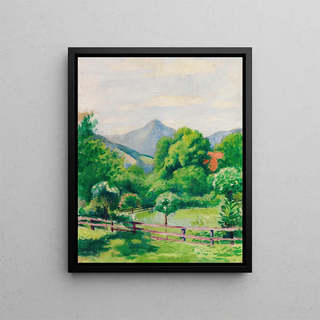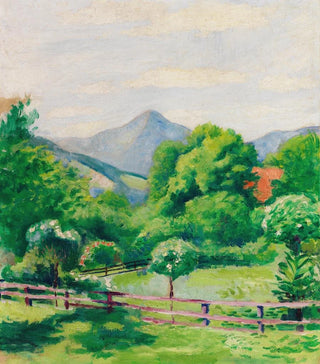Art print Garden at Tegernsee with house and mountain - August Macke | Art print


View from behind

Frame (optional)
At the heart of German Expressionism, "Garden at Tegernsee with House and Mountain" by August Macke stands as an iconic artwork, capturing the essence of an idyllic landscape. This painting, evoking an atmosphere of serenity and contemplation, transports the viewer to a space where nature and architecture coexist harmoniously. The vibrant colors and bold composition invite a complete immersion into this pictorial universe, where each element seems to tell a story. As you contemplate this piece, you are immediately struck by the brightness emanating from the chosen hues, creating a dialogue between the sky, the earth, and the architecture.
Style and uniqueness of the work
August Macke's style is distinguished by his ability to blend abstraction and representation. In "Garden at Tegernsee with House and Mountain," the artist employs simplified forms and pure colors to evoke a subjective reality, far from the rigor of realism. The contours of the mountains are drawn with lightness, while the house, anchored in the lush garden, almost seems to float in this dreamlike space. The play of light and shadow, along with contrasting colors, creates a captivating visual dynamic. This artwork is a true ode to nature, where each brushstroke conveys joy of living and wonder at the beauty of the world. Macke manages to transform a simple garden into a meeting place between man and nature, offering a unique perspective on the environment around him.
The artist and his influence
August Macke, a major figure of the Expressionist movement, left his mark on his era with a bold artistic vision. Born in 1887 in Meschede, he quickly developed a distinctive style, influenced by his travels and encounters with other contemporary artists. His association with the group Der Blaue Reiter, which championed the expression of emotions through color, profoundly impacted his work. Macke was able to incorporate elements of Eastern culture and Japanese inspirations, enriching his visual language. His ability to capture the present moment and translate complex emotions into images made him

Matte finish

View from behind

Frame (optional)
At the heart of German Expressionism, "Garden at Tegernsee with House and Mountain" by August Macke stands as an iconic artwork, capturing the essence of an idyllic landscape. This painting, evoking an atmosphere of serenity and contemplation, transports the viewer to a space where nature and architecture coexist harmoniously. The vibrant colors and bold composition invite a complete immersion into this pictorial universe, where each element seems to tell a story. As you contemplate this piece, you are immediately struck by the brightness emanating from the chosen hues, creating a dialogue between the sky, the earth, and the architecture.
Style and uniqueness of the work
August Macke's style is distinguished by his ability to blend abstraction and representation. In "Garden at Tegernsee with House and Mountain," the artist employs simplified forms and pure colors to evoke a subjective reality, far from the rigor of realism. The contours of the mountains are drawn with lightness, while the house, anchored in the lush garden, almost seems to float in this dreamlike space. The play of light and shadow, along with contrasting colors, creates a captivating visual dynamic. This artwork is a true ode to nature, where each brushstroke conveys joy of living and wonder at the beauty of the world. Macke manages to transform a simple garden into a meeting place between man and nature, offering a unique perspective on the environment around him.
The artist and his influence
August Macke, a major figure of the Expressionist movement, left his mark on his era with a bold artistic vision. Born in 1887 in Meschede, he quickly developed a distinctive style, influenced by his travels and encounters with other contemporary artists. His association with the group Der Blaue Reiter, which championed the expression of emotions through color, profoundly impacted his work. Macke was able to incorporate elements of Eastern culture and Japanese inspirations, enriching his visual language. His ability to capture the present moment and translate complex emotions into images made him
12,34 €






